The formation of small cysts in the ovaries, which often leads to a violation of reproductive function, is a fairly common disease. According to the WHO, this pathology occurs in 7-10% of women who turn to a gynecologist with internal genital problems.
The disease is accompanied by various disorders in the hormonal system. With neglected forms, the probability of infertility is high.
What is dangerous for polycystic ovary
Since changes in the structure of the ovaries are accompanied by hormonal changes in the body, many women present the following complaints to gynecologists:
- First of allladies note the deterioration of the skin and hair on the head. The skin becomes oily, a large number of acne appears. Hair also changes color, and the head seems dirty.
- In this contingent of patients, body weight often increases sharply. A patient can gain up to 20 kilograms excess weight within a month.
- Sometimes women fall into the surgical department, because they are concerned about severe abdominal pain and pelvic area, which are permanent and difficult to stop.
- Under the influence of the hormonal shift, the structure of the hair cover changes. Ladies complain about the appearance of hair on the face, chest, stomach.

Modern medicine offers women two directions in solving this problem. Most often, doctors conduct hormone replacement therapy, and at its low efficiency recommend to their patients surgical treatment.
Folk techniques in the treatment of cystic ovaryectomy are widely used as an auxiliary. Medicinal herbs can significantly reduce the amount of hormonal drugs, in addition, folk therapy doctors successfully use in the postoperative period.
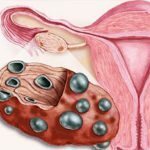 We recommend to read an article on the treatment of polycystic ovaries. From it you will learn about the causes of the disease, the consequences of untreated polycystosis, effective methods of treatment.
We recommend to read an article on the treatment of polycystic ovaries. From it you will learn about the causes of the disease, the consequences of untreated polycystosis, effective methods of treatment.
And here it is more in detail about, whether it is possible to become pregnant at a polycystosis of ovaries.
Polycystic ovary syndrome is a serious disease that requires a whole range of therapeutic measures. In most women, this pathology can occur with minimal symptoms, and often problems with the ovaries are diagnosed in them only after the appearance of severe hormonal disorders.
Completely get rid of the problem can only be through the operation. Although modern medicine offers the most sparing methods, in particular, laparoscopy, but any surgical intervention is a physiological and mental shock for a woman.
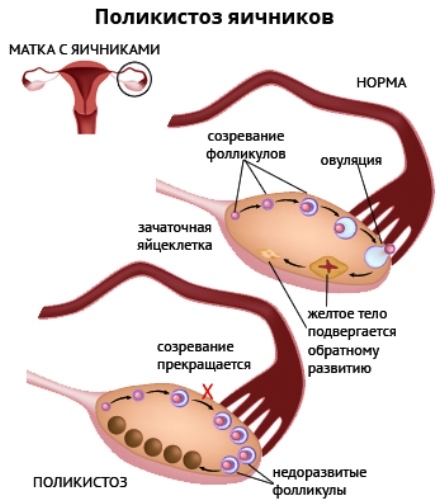
Conservative therapy is most often aimed at restoring the hormonal balance, removing inflammation from the affected ovaries, arresting the pain syndrome. Important in the treatment of polycystosis is the reduction of the body weight of the patient, reducing the blood sugar in the woman, restoring a normal and stable menstrual cycle.
Exclusively medicinal plants to solve all problems, of course, will not succeed. Doctors recommend folk remedies to use as an auxiliary method, which will significantly reduce the use of medicines of factory production.
Look at the video about polycystic ovary:
Treatment with herbs
Cystic changes in the ovaries are well suited for herbal therapy. To get a better effect, specialists in the field of traditional medicine recommend using certain combinations of medicinal plants.
Collecting with polycystic ovary
Most often, the experts recommend the following prescription to the patients:
- To prepare a healing drink, you need to take 25 grams of shepherd's purse, rowan berries, nettles, uterine borax and radix rhizomes. All ingredients are mixed and finely crushed with a mixer.75 - 100 grams of the powder obtained are poured into a pan or thermos, poured with boiling water and insisted in a dark place for 12 to 18 hours. For 45 - 60 days, this infusion is taken 50 grams 3 times a day, 15 minutes after eating.
Good results on restoring hormonal balance and improving the work of affected ovaries can be achieved if you take advantage of the following recommendations of traditional healers:
- It is necessary to mix in equal proportions hips and hawthorn fruits, currant leaves and cuffs. To the received green weight add half the grass of the shepherd's bag, thyme and mint. The blended mixture is ground, and 300 grams of powder are covered in a thermos and poured with steep boiling water. The drink should be infused for 24 hours, after which it is recommended to use 50 grams 3 times a day. The course of treatment of polycystic ovaries such infusion should not be less than 30 days.
If the patient has passed the process to chronic form, then to strengthen the standard therapy, it is advised to drink a herbal drink for 60 days, which must include the motherwort, chamomile flowers, bilberry bilberries and nettle leaves. These herbs help restore menstrual function in a sick woman, in addition, this collection is a prophylaxis of uterine bleeding, which is possible with the massive use of hormonal drugs.

Better herbs
In the manuals on traditional medicine, the treatment of diseases of the female sexual sphere is given enough attention. In particular, there is a fairly large list of herbs used by specialists for the treatment of ovarian cysts and associated hormonal disorders.
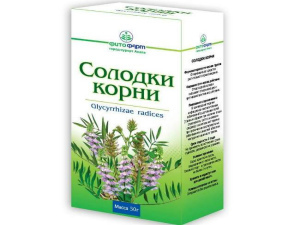 The most favorite medicinal herb of most gynecologists is the licorice root. This plant has a pronounced antimicrobial effect, increases the excretion of the products of vital activity from cells, soothingly acts on the nervous system of the patient.
The most favorite medicinal herb of most gynecologists is the licorice root. This plant has a pronounced antimicrobial effect, increases the excretion of the products of vital activity from cells, soothingly acts on the nervous system of the patient.
Licorice has a beneficial effect on liver function, lowers blood glucose and cholesterol, and increases immunity. Directly for the treatment of cystic changes in the female ovaries this plant is prescribed because the licorice root sharply reduces the level of male sex hormones in the female body.
Preparing a medical drink is very simple: a shredded plant( 50 grams) is poured with a liter of boiling water, insist 2 - 3 hours. This amount of medicinal tincture should be enough for the patient for 2 days. It should be remembered that the plant can not be taken more than 30 days.
To the herbs that can reduce the level of testosterone in a sick woman, experts also include the well-known peony. Due to its properties this plant has received the second name - "Maryin root".
35 - 40 grams of chopped herbs are poured with boiling water, using only enameled dishes. The mixture is insisted for 12 hours, filtered and taken 50 grams 3 times a day.
According to many experts, the root of licorice and peony perfectly complement each other, so these two plants are advised to appoint women simultaneously. The only condition is that these infusions are taken only after eating, since they can cause irritation of the gastric and intestinal walls.
To reduce testosterone levels in polycystic ovaries, doctors often advise patients to take infusions and decoctions based on field horsetail. This plant in its properties is very similar to the known diuretic drug Veroshpiron.
Grass contains a whole complex of vitamins, especially horsetail with ascorbic acid. The plant helps to reduce the amount of testosterone, as it removes excess fluid from the tissues. A peculiarity of the infusions from this gift of nature is the preservation in the cells of calcium and silicon.
With polycystosis, the plant helps to reduce the size of the cysts themselves, stabilizes the menstrual cycle of a woman, and takes an active part in restoring the hormonal balance. Specialists advise to take the root of a dandelion in the form of a diluted chemically dry mixture or in the form of a decoction:
- 100 grams of dry root of a field plant is ground with a mixer, poured with 1.5 liters of water and cooked at low heat for 1 hour. After that, the drink should be infused in a dark cool place 2 - 3 hours. The received infusion can be taken 50 grams 2 to 3 times a day. The duration of the drug is almost unlimited.
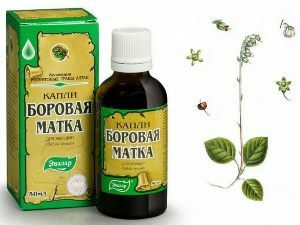 In the treatment of many diseases of the female genital area, specialists successfully use medicinal drinks prepared from the uterine hog.
In the treatment of many diseases of the female genital area, specialists successfully use medicinal drinks prepared from the uterine hog.
The plant itself weakly affects the hormonal background of the woman, but in complex use, this herb enhances the effect of other herbs, while also contributing to the reduction of ovarian cysts in size.
In addition, the hogweed does not have any negative impact on the female body, so the period of its use is almost unlimited. The herb reduces inflammation in the patient's appendages, restores the immune system.

In the treatment of such pathology, specialists in the field of traditional medicine widely use other plants. Most often we are talking about mint, milk thistle, nettles, green tea, grass volosushka and others. However, most of them use numerous popular medicinal doses as ingredients, since in this case a more pronounced therapeutic effect can be obtained.
And here is more about the ovarian hormonal cyst.
Polycystic ovary is a rather insidious disease that can deprive a woman of the joy of motherhood. Therefore, before beginning treatment of this disease with herbs and other folk remedies, women should seek help from a doctor. Women should remember that some medicinal plants can help only a limited number of patients, and most often this therapy should be included as an auxiliary measure in the classic treatment of polycystic ovaries.

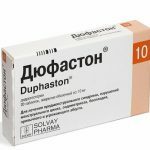 We recommend to read an article on the treatment of polycystic ovary Duphaston. From it you will learn about the drug and its effects, the use of the drug in polycystosis, and also about treatment with Utrozhestan.
We recommend to read an article on the treatment of polycystic ovary Duphaston. From it you will learn about the drug and its effects, the use of the drug in polycystosis, and also about treatment with Utrozhestan.